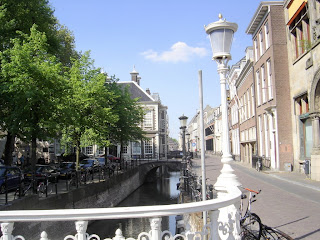Away from the coastal marshlands of Holland that would take centuries to reclaim much later, Romans founded a fortress. They named it Traiectum (ford) as this is where the Rhine, which used to flow much more northerly in the olden days, was forded. As Romans also decided that this was as far to the north as their empire was going to expand, they put Ultra (the farthest) in front of the name. Many centuries after their empire collapsed, the two words would come to be shortened to simply Utrecht.
 There is a big 400-year- long blank in the city's history between the time when the Romans left and its sudden shot to prominence as the centre of Christianity of the Low Lands. Those were the Dark Ages of Europe: while the Japanese were busy blending perfumes and competing in love poetry, in the Western extreme of Eurasia assorted tribes were dragging a beastly existence on the ashes of the Roman Empire. Nothing is known of Utrecht of those days until it erupts with a succession of churches, archbishops and cathedrals starting in the 8th century.
There is a big 400-year- long blank in the city's history between the time when the Romans left and its sudden shot to prominence as the centre of Christianity of the Low Lands. Those were the Dark Ages of Europe: while the Japanese were busy blending perfumes and competing in love poetry, in the Western extreme of Eurasia assorted tribes were dragging a beastly existence on the ashes of the Roman Empire. Nothing is known of Utrecht of those days until it erupts with a succession of churches, archbishops and cathedrals starting in the 8th century.
It is no coincidence that the treaty that put foundation to the later Dutch Republic was signed in Utrecht, the famous Utrecht Union. Nowadays, Utrecht is the central seat of the Old Catholic Church, right in the middle of a staunchly Protestant area. In true adherence to the Utrechter spirit, Old Catholics broke away from Rome outraged by the declaration of the Pope's infallibility.








.gif)






